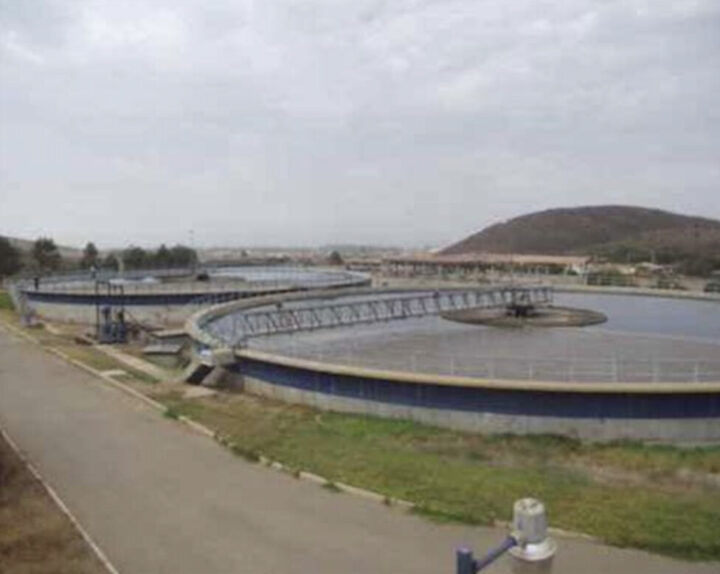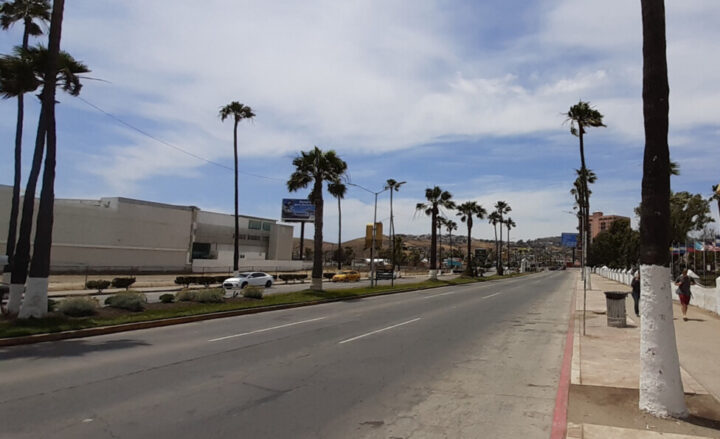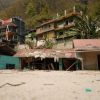Friday, April 26, 2024
News and Views from the Global South
Caribbean Climate Wire
Mexico Needs to Step Up Treatment and Reuse of Water to Address Crisis

The expansion towards the mountains of the coastal city of Ensenada, in the northwestern Mexican state of Baja California, stresses the water supply, which is scarce in this peninsular region due to its arid nature and deficiencies in water management. CREDIT: Emilio Godoy/IPS
- At the entrance to the coastal city of Ensenada in the northwestern Mexican state of Baja California a sign reads: “Every drop matters to us. Take care of the water.”
The message is important, as the city faces shortages due to hoarding by agricultural producers and builders, as well as the drought that has become more severe because of the effects of the climate emergency.
But cities such as Ensenada, which has a population of 443,000 and is located 2,883 kilometers from Mexico City, do not take sufficient advantage of the reuse of water, a technique that along with other measures can contribute to the fight against the water shortage at a time when Mexico is suffering from intense drought and an unusual heat wave.
Independent expert Adrián González said a conventional focus on obtaining water that ignores improvements in its use continues to prevail.
“There is enough water, but there is hoarding. We consume a lot. It is a question of management. Consumption can be moderated, there are experiences around the world in this regard,” he told IPS.
Demand exceeds supply, and supply cuts and overexploited sources dry up the water supply. The delivery and sale of water in “pipas” or tanker trucks is a common sight in Ensenada, located in an arid region between the Pacific Ocean and the mountains.
Due to the overexploitation of the aquifers and the growing demand, Ensenada is suffering from a deficit, so long-term solutions are urgently needed.
Consumption stands at about 1,000 liters per second (l/s), which should increase to about 1,260 in 2030, while supply totals about 800 l/s, according to the State Water Commission, the government agency responsible for water resource management in Baja California, on the peninsula of the same name, bordering the United States.
While installed capacity and treatment are on the rise, a widespread problem lies in the historical lack of efficiency and maintenance of facilities, which limits the scope of the available technologies.
In 2021, coverage reached 67.5 percent of the wastewater generated and collected in the municipal sewage systems of this Latin American country, just a few tenths more than the previous year, according to data from the National Water Commission (Conagua).
Treated water can be used for agricultural irrigation, gardening, domestic and industrial uses, and can help recharge aquifers.
Local water agencies can undertake aquifer recharge projects, but incentives for doing so are needed. In fact, the legal framework does not stipulate recovery rights for reused water, which falls under the general jurisdiction of Conagua.

The El Naranjo municipal treatment plant in the city of Ensenada, in the northwestern peninsular state of Baja California, is operating below its installed capacity, which is further affecting the distribution of scarce water in the city. CREDIT: Conagua
Mexico, with a population of 128 million inhabitants spread over an area of 1.96 million square kilometers, is facing increasing water stress, ranking 24th among the countries in the world with this phenomenon, caused by overexploitation, pollution, scarcity and inequity in access to water.
In 2021, 2,872 water reuse plants were operating in Mexico – three percent more than the previous year-, with an installed capacity of 198,603 l/s and a treated flow of 145,341 l/s, just 0.5 percent above the 2020 level.
The northern state of Sinaloa has the largest number of plants (311), followed by Durango also in the north (241) and neighboring Chihuahua (195). Despite their water needs, those with the smallest number of plants are the southeastern state of Campeche and the northern state of Coahuila (27 each), which furthermore operate below capacity.
There are 44 plants operating in Baja California, with an installed capacity of 7692 l/s and a performance of 6222. At the same time, 14 of the 48 groundwater reservoirs in the state, including the Ensenada reservoir, suffer shortages because annual extraction exceeds renewal.
Regional and federal authorities have resorted to seawater desalination in the state, but it only refines about 130 l/s, out of a capacity of 250.
Martín Zepeda, founder of the non-governmental Citizens’ Water Commission, criticized the measures applied so far in the reuse of water.
“We have only achieved palliative measures. We have been suffering from the same problems for 30 years,” he stressed.

The coastal city of Ensenada in the northwestern Mexican state of Baja California depends on aquifer extraction, seawater desalination and the transfer of water from the state of Tijuana, also on the U.S. border, as not enough water is reused. CREDIT: Emilio Godoy/IPS
Baby steps
In another northern state, in the east, Nuevo León, reuse is showing signs of success, but more progress is needed.
Antonio Hernández, a researcher with the non-governmental organization Pronatura Noreste, stressed to IPS the need for treated water infrastructure.
“We don’t have a sufficient network to distribute the treated water available. In 2022, when the water shortage crisis began, the agency responsible instructed the municipalities to buy treated water and thus take pressure off the groundwater,” he told IPS from Monterrey, Nuevo León’s capital.
“The transfer was to be by truck. But it did not happen, because the municipalities did not buy the water nor did the government build the distribution network. Availability does not mean accessibility,” he said.
In 2022, Nuevo León, especially greater Monterrey with a population of more than five million people, faced a severe water crisis.
As a result, the authorities resorted to supply cuts, rate hikes, anti-waste fines and awareness campaigns on water usage.
In that state, 13 of the 24 aquifers are overexploited, including the one outside of Monterrey proper.
The population of Monterrey drinks about 16,000 l/s, which results in a deficit of about 3,000 l/s. That means the 56 treatment plants are insufficient, managing 12,387 l/s, compared to an installed capacity of 16,162 l/s.

Mexico does not take sufficient advantage of wastewater reuse, which can be used to recharge aquifers, for consumption in industrial facilities, for agricultural irrigation or for urban use. Pictured is a fountain in a park in a neighborhood in south-central Mexico City. CREDIT: Emilio Godoy/IPS
Half-hearted measures
Despite the problems faced by the plants, the Federal Attorney General’s Office for Environmental Protection (Profepa) only inspected four municipal facilities, most of them private, in 2016 in Baja California, where it found “minor irregularities” and charged fines in three, according to a public information request filed by IPS.
In Mexico City, only two were inspected – in 2018 and in 2022 – and minor irregularities were found in one private municipal plant, although it was not fined. In 2018, Profepa visited four plants in Nuevo León in which it found minor irregularities.
In total, Profepa inspected a total of 330 plants, including 50 in the western state of Jalisco and 33 in the northern state of Chihuahua. Of that total, it found minor irregularities in 234, and none in 69.
Focus on pipes and little else
The generalized view is the conventional one of promoting the construction of infrastructure to face the crisis, without addressing the scarcity of water resources.
The current Mexican government boasts that it is promoting 15 water projects, such as the construction of dams, aqueducts and treatment plants, mainly in the north of the country to combat the crisis.
In places like Ensenada, the outlook is no different.
Over the next few years, the State Water Commission foresees the expansion of the desalination plant, the modernization of an aqueduct, the rehabilitation of five treatment plants, the delivery of treated water to the agricultural zone, and the rehabilitation of pumping plants and wells.
Despite the situation, the Baja California state government is just now drafting its water plan for the 2022-2027 period.
In Nuevo León, authorities announced the digging of more wells, the construction of the Libertad dam, the El Cuchillo II Aqueduct and four treatment plants, as well as the modulation of pressure to reduce waste.
The Libertad dam will have a capacity of 1,500 l/s, at a cost of some 350 million dollars. Meanwhile, the aqueduct will transport 5,000 l/s, thanks to an investment of some 495 million dollars.
Mexico has also benefited from international financing for water projects. Since 1997, the North American Development Bank has financed 27 water and sanitation projects in Baja , in addition to three in Nuevo León since 2001.

The Norte treatment plant in the Mexican state of Nuevo León seeks to promote water reuse for automobile assembly, urban and agricultural activities in an area that experienced a severe water crisis in 2022. CREDIT: Conagua
Its financing of a 6.8 million dollar wastewater management initiative in the city of Mexicali is currently under public consultation.
In addition, the U.S.-Mexico binational financial institution is backing the issue of a 150 million dollar green bond for water projects.
The experts consulted proposed several measures, such as awareness campaigns, water reuse, and leak repair.
González, the independent expert, said the combination of reuse and efficiency offers very low costs and promising results.
“There is not going to be just one single solution. Fate is going to catch up with us. We can’t continue following strategies that have never worked and that have been exhausted,” he argued.
Zepeda, the water activist, also suggested the creation of a citizen water commission to audit the operation of the system.
“The situation is not going to improve until availability and uses are corrected. It is a combination of water sources and activities. We need long-term solutions,” he said.
Meanwhile, Hernández the researcher proposed a revision of zoning and land use plans to address the construction of neighborhoods, golf courses and vehicle assembly plants, to promote the efficient use of water.

 Print
Print



